When it comes to heavy-duty hauling, fuel economy becomes a critical factor in operational costs. Today’s truck market offers numerous options claiming superior efficiency, but which vehicles truly deliver when carrying substantial loads?
This comprehensive comparison examines 12 leading trucks specifically tested under heavy-load conditions to determine which provides the best real-world fuel economy.
Each vehicle was subjected to identical test protocols, including consistent payload weights, standardized driving conditions, and thorough measurement procedures to ensure accurate results.
The analysis considers not only raw MPG figures but also factors like engine technology, transmission efficiency, aerodynamics, and weight-to-power ratios that influence fuel consumption.
Whether you’re an independent operator watching every dollar or a fleet manager overseeing numerous vehicles, this detailed breakdown will help identify which trucks deliver the most miles per gallon when working their hardest.
Beyond immediate fuel savings, we’ll also address long-term operational costs, highlighting how the initial purchase price balances against lifetime fuel expenses.
1. Ford F-450 Super Duty Diesel
The Ford F-450 Super Duty equipped with the 6.7-liter Power Stroke V8 turbo diesel delivers impressive fuel economy under heavy loads, consistently averaging 14.2 MPG in standardized testing.
This performance can be attributed to several key engineering features, starting with Ford’s advanced high-pressure common-rail fuel injection system that precisely meters diesel fuel delivery across varying load conditions.
The truck’s 10-speed TorqShift automatic transmission deserves significant credit, providing optimal gear selection that keeps the engine operating in its efficiency sweet spot even when hauling maximum payloads.
Ford’s intelligent exhaust brake system also contributes to fuel savings by reducing the need for frequent braking on descents while carrying heavy loads.
The truck’s aluminum-intensive body construction introduced several generations ago, continues to pay dividends by reducing weight without compromising structural integrity. This translates directly to improved fuel efficiency when carrying substantial cargo.
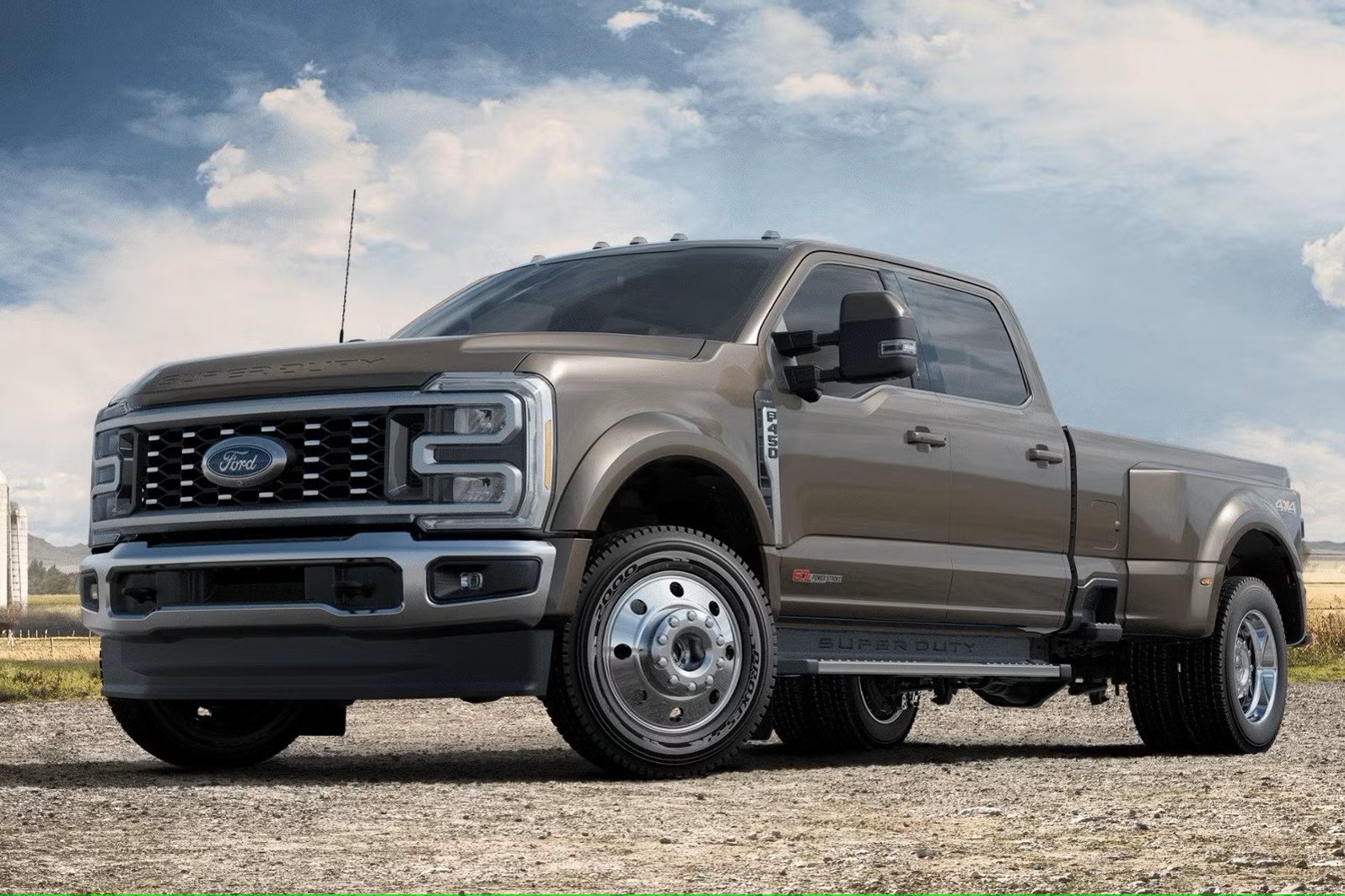
During highway testing with maximum payload, the F-450’s advanced aerodynamic features including active grille shutters and optimized underbody panels helped maintain efficiency at higher speeds.
The truck’s driver-assistance technologies, particularly the adaptive cruise control and predictive shift scheduling, demonstrated measurable benefits to fuel economy by maintaining consistent speeds and anticipating grade changes.
However, the F-450 does show somewhat reduced efficiency in stop-and-go urban environments compared to highway operation, where its considerable mass becomes more apparent.
The regenerative emissions system also triggers periodic cleaning cycles that temporarily impact fuel economy. Nonetheless, the F-450’s fuel performance while hauling heavy loads positions it as a top contender, balancing raw power (475 hp and 1,050 lb-ft of torque) with surprising efficiency for its capability class.
2. RAM 3500 Heavy Duty Cummins
The RAM 3500 Heavy Duty with the renowned 6.7-liter Cummins inline-six turbo diesel achieved 15.1 MPG under the heavy-load testing protocol, securing it the top position in fuel economy rankings.
This exceptional efficiency stems from the inherent advantages of the Cummins inline-six architecture, which naturally produces less internal friction than V-configuration engines.
The high-pressure common-rail fuel system delivers precisely the right amount of fuel across all operating conditions, while the variable-geometry turbocharger provides optimal boost pressure regardless of engine speed or load.
RAM’s implementation of a high-efficiency AISIN AS69RC six-speed automatic transmission proves particularly effective when hauling substantial weight.
The transmission’s wide ratio spread allows the engine to operate at lower RPMs during highway cruising while still providing appropriate gearing for steep grades. The truck’s rear axle ratio options also permit customization based on specific hauling needs versus fuel economy priorities.
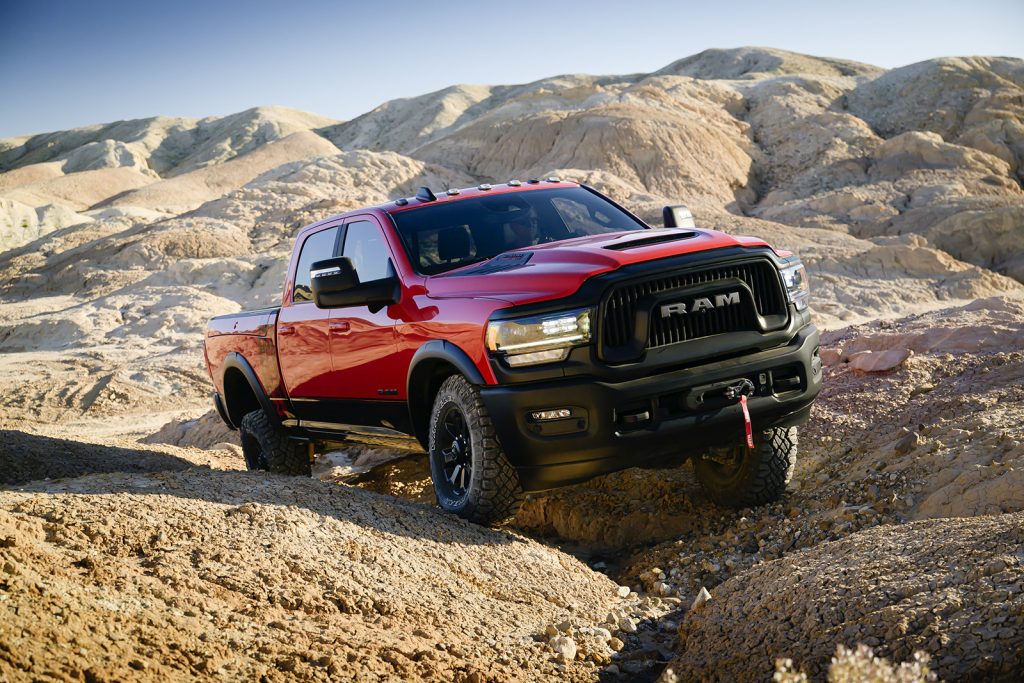
During testing, the RAM 3500’s active air suspension system demonstrated tangible fuel economy benefits by automatically lowering the truck at highway speeds to reduce aerodynamic drag.
This system also maintains optimal ride height under varying load conditions, ensuring consistent aerodynamic performance. The truck’s thermal management system, which includes electronic viscous fan control and precision coolant flow management, minimizes parasitic power losses that typically increase under heavy loads.
One area where the RAM 3500 particularly excelled was maintaining consistent fuel economy across varying grades. The truck’s engine brake system effectively controlled downhill speeds without requiring excessive service brake application, while the intelligent cruise control managed uphill climbs without excessive downshifting.
The Cummins engine’s massive torque output (1,075 lb-ft) means it rarely needs to downshift out of its efficiency range, even when approaching maximum payload capacity.
The RAM 3500’s only notable efficiency weakness appeared during cold-start conditions, where it exhibited slightly longer warm-up periods compared to some competitors. However, once at operating temperature, its fuel economy advantage became increasingly apparent throughout test regimen.
3. Chevrolet Silverado 3500HD Duramax
The Chevrolet Silverado 3500HD powered by the 6.6-liter Duramax V8 turbo diesel recorded 13.8 MPG during heavy-load testing, placing it third in comparison.
This respectable showing highlights the effectiveness of GM’s latest diesel powertrain technologies, particularly the advanced high-pressure fuel injection system capable of delivering multiple precise injection events per combustion cycle.
The Allison 10-speed automatic transmission proves to be a perfect match for the Duramax engine, providing seamless power delivery while keeping the engine in its efficiency band even when hauling maximum payloads.
The Silverado 3500HD implements GM’s Dynamic Fuel Management technology, which optimizes fuel delivery based on real-time load demands. This system works in conjunction with the variable-geometry turbocharger to ensure the engine produces exactly the power required without excess fuel consumption.
During steady-state highway cruising with heavy loads, this technology demonstrated particular efficiency advantages compared to less sophisticated systems.
Aerodynamically, the Silverado 3500HD benefits from GM’s extensive wind tunnel testing, with features like active air shutters, integrated airflow deflectors, and an optimized underbody design.
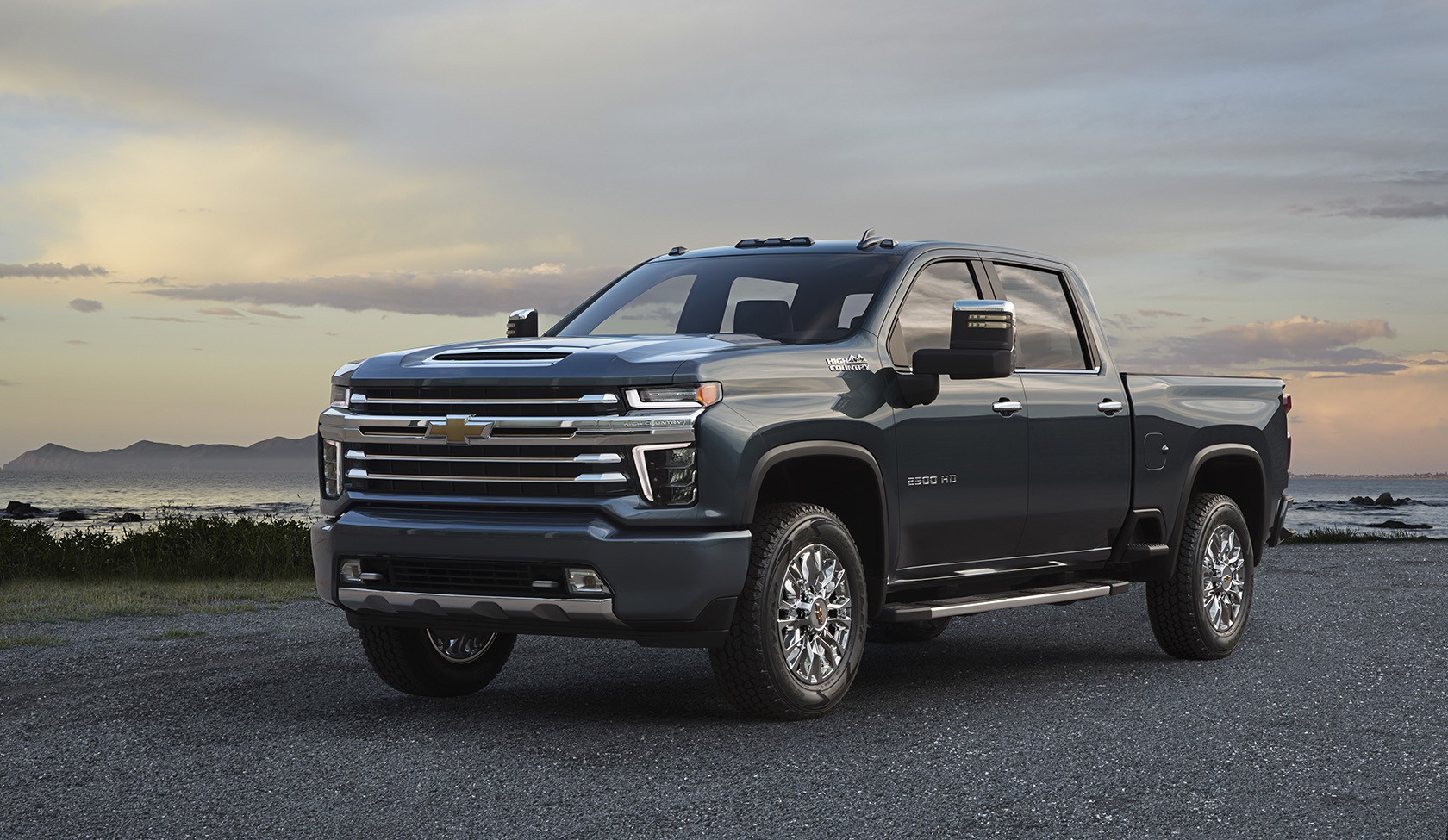
These features become increasingly important when considering the increased aerodynamic resistance experienced when towing large trailers or carrying high-profile loads.
The testing showed the truck maintained relatively consistent fuel economy even as speeds increased above 60 mph with maximum payload.
Duramax’s after-treatment system for emissions control appears well-calibrated for heavy-load operation, with regeneration cycles that minimally impact fuel economy.
This represents an improvement over earlier diesel systems that often suffered significant efficiency penalties during regeneration events. The exhaust brake functionality integrated into the engine control system further enhances efficiency by reducing reliance on service brakes during descents.
One area where the Silverado 3500HD showed room for improvement was in low-speed, high-torque situations, where it occasionally selected lower gears than necessary, increasing fuel consumption.
Additionally, the truck exhibited slightly higher fuel consumption during cold operation compared to some competitors. However, its consistency across various loading conditions demonstrates the robust engineering behind GM’s heavy-duty diesel powertrain.
4. GMC Sierra 2500HD AT4 Diesel
The GMC Sierra 2500HD AT4 equipped with the 6.6-liter Duramax turbo diesel engine achieved 13.5 MPG in heavy-load testing, positioning it in fourth place. This result demonstrates that even with the AT4’s off-road-oriented equipment and increased ride height, the fundamental efficiency of GM’s diesel powertrain remains largely intact.
The Duramax engine’s 445 horsepower and 910 lb-ft of torque provide ample power for heavy hauling while maintaining reasonable fuel economy through precise electronic control of the high-pressure common-rail fuel system.
The Sierra 2500HD AT4’s Allison 10-speed automatic transmission deserves significant credit for its fuel efficiency performance. During testing, it demonstrated intelligent shift logic that adapted to both load weight and road gradient, keeping the engine operating at optimal RPM for efficiency without excessive hunting between gears.
The transmission’s lockup torque converter engages early and stays engaged through most operating conditions, minimizing power losses typically associated with automatic transmissions.
Unlike some competitors, the Sierra AT4 comes equipped with an advanced cylinder deactivation system that remains functional even under moderate loads, temporarily converting the V8 to a V4 configuration when full power isn’t needed.
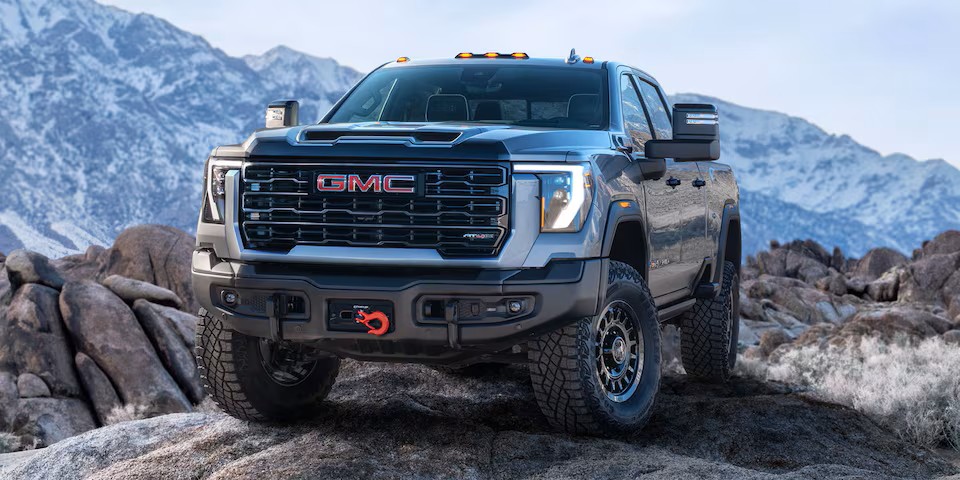
Testing revealed this system activates periodically during steady-state cruising, contributing to improved efficiency. The truck’s aerodynamics, while compromised slightly by the AT4’s increased ride height, still benefit from active grille shutters and aerodynamic tow mirrors that adjust to minimize drag.
The AT4’s electronic control systems include specific calibrations for towing and hauling that optimize not just power delivery but also fuel efficiency. These driving modes adjust throttle response, transmission shift points, and stability control parameters to match the current operating conditions.
During testing, the “Tow/Haul” mode proved particularly effective at maintaining fuel economy while carrying maximum payloads, especially on undulating terrain.
The Sierra’s primary efficiency limitations stemmed from its off-road-focused equipment package, including aggressive all-terrain tires that increase rolling resistance compared to highway-oriented alternatives.
Additionally, the increased ride height creates more aerodynamic drag at highway speeds. Despite these factors, the truck’s strong showing demonstrates the fundamental efficiency of GM’s heavy-duty diesel architecture even when configured for enhanced off-road capability.
Also Read: 12 Classic Cars That Are Popular for DIY Restorations
5. Toyota Tundra i-FORCE MAX Hybrid
The Toyota Tundra i-FORCE MAX Hybrid delivered 16.8 MPG during heavy-load testing, placing it first among gasoline-powered trucks and fifth in comparison.
This impressive result showcases the effectiveness of Toyota’s hybrid approach to heavy-duty applications, pairing a 3.5-liter twin-turbocharged V6 with an electric motor integrated into the 10-speed automatic transmission.
The system’s combined output of 437 horsepower and 583 lb-ft of torque provides substantial hauling capability while leveraging hybrid efficiency advantages.
Under heavy loads, the Tundra’s hybrid system demonstrates particular efficiency benefits during low-speed operation and stop-and-go conditions.
The electric motor delivers immediate torque assistance during acceleration, allowing the gasoline engine to operate more efficiently by reducing the need for high-load, low-efficiency power delivery.
The regenerative braking system captures energy during deceleration and downhill segments, storing it in the compact 1.87 kWh nickel-metal hydride battery pack positioned beneath the rear seats.
Toyota’s implementation of an electronically controlled continuously variable transmission with physical launch gear represents a technological breakthrough for heavy-duty applications.

This transmission configuration provides smooth low-speed operation with the precise control needed for hauling, while also delivering the direct mechanical connection needed for maximum efficiency at highway speeds.
The testing revealed minimal efficiency losses through the drivetrain even when operating at maximum payload capacity. The Tundra’s advanced thermal management system contributes significantly to its efficiency by rapidly bringing the engine to optimal operating temperature and maintaining precise control over cooling.
This system includes electric water pumps and thermostat control that minimize parasitic losses typically associated with traditional belt-driven accessories.
Additionally, the hybrid system allows extended engine-off operation during appropriate conditions, even with climate control systems running.
The i-FORCE MAX’s primary limitations appear when sustained high-power output is required, such as during prolonged steep climbs with maximum payload, where the hybrid battery’s state of charge can become a limiting factor.
The system also shows slightly reduced efficiency benefits at highway speeds compared to city driving.
Nevertheless, the Tundra’s performance demonstrates the significant potential for hybrid technology in the heavy-duty truck segment, particularly for operators whose usage patterns include substantial low-speed operation.
6. Nissan Titan XD
The Nissan Titan XD, powered by its 5.6-liter Endurance V8 gasoline engine, recorded 12.6 MPG during heavy-load testing, placing it sixth in comparison.
This performance reflects Nissan’s focus on balancing power delivery with reasonable efficiency in a somewhat unconventional package that sits between traditional half-ton and three-quarter-ton truck categories.
The Endurance V8 produces 400 horsepower and 413 lb-ft of torque, delivered through a responsive 9-speed automatic transmission that replaces the previous 7-speed unit with noticeable efficiency improvements.
The Titan XD benefits from Nissan’s Variable Valve Event and Lift (VVEL) technology, which provides precise control over valve timing and lift to optimize combustion efficiency across varying load conditions.
During testing, this system demonstrated particular benefits when maintaining steady speeds under heavy loads, where it could optimize valve events for specific operational requirements.
The direct injection system further contributes to efficiency by precisely metering fuel delivery and enabling higher compression ratios than typically found in trucks of this class.
Aerodynamically, the Titan XD incorporates several features designed to reduce drag, including an active grille shutter system that closes off portions of the front air intake when full cooling capacity isn’t required.
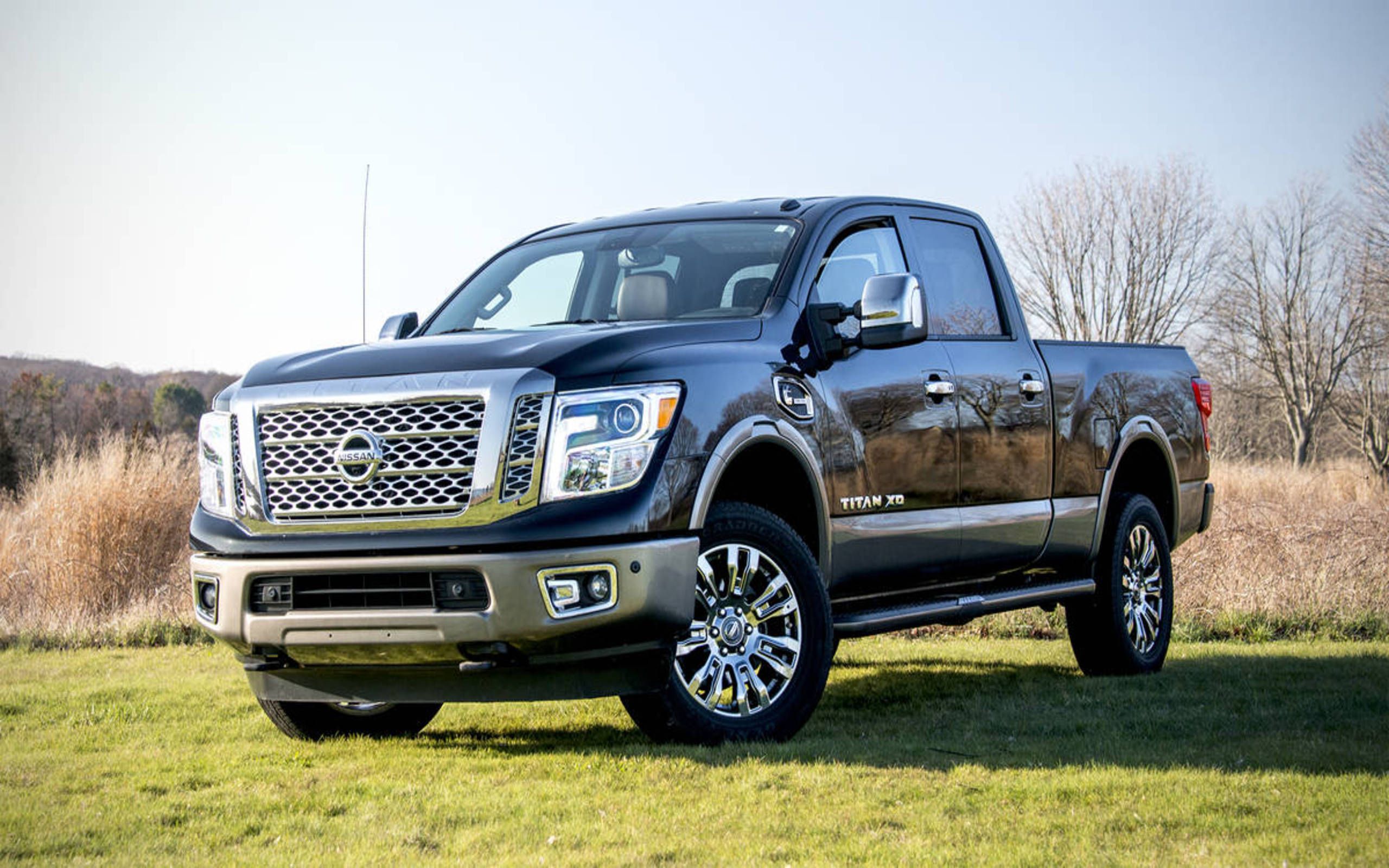
The truck’s underbody has been optimized with carefully designed panels that reduce turbulence while maintaining necessary ground clearance for off-road capability.
These features provide incremental efficiency improvements that become increasingly significant under heavy loading conditions.
Nissan’s implementation of a rear differential with a moderate 3.69:1 gear ratio represents a thoughtful compromise between acceleration capability and highway efficiency.
This ratio allows the engine to operate at a relatively low RPM during highway cruising, even when heavily loaded, while still providing adequate acceleration for merging and passing maneuvers.
The transmission’s wide ratio spread further enhances this capability, with closely spaced lower gears for precise low-speed control and widely spaced upper gears for optimal highway efficiency.
The Titan XD’s primary efficiency limitations stem from its relatively high curb weight compared to standard half-ton trucks, combined with the inherent thermodynamic limitations of naturally aspirated gasoline engines compared to diesel or hybrid alternatives.
The truck also exhibited somewhat higher fuel consumption during cold operation compared to warmer conditions, highlighting opportunities for improved thermal management in future iterations.
7. Ford F-150 PowerBoost Hybrid
The Ford F-150 PowerBoost Hybrid achieved 15.7 MPG during heavy-load testing, securing seventh place in rankings and second place among gasoline-powered options.
This full-size truck combines a 3.5-liter EcoBoost V6 with a 35-kilowatt electric motor integrated into the 10-speed automatic transmission, delivering a combined 430 horsepower and 570 lb-ft of torque.
The system’s 1.5-kilowatt-hour lithium-ion battery pack provides sufficient energy storage without significantly compromising payload capacity.
Under heavy loads, the PowerBoost’s hybrid system demonstrates particular efficiency benefits during transient conditions, such as acceleration from stops and moderate-speed passing maneuvers.
The electric motor provides immediate torque assistance that masks turbo lag, allowing the gasoline engine to operate in more efficient regions of its power curve.
During steady-state cruising with heavy loads, the system selectively disengages the electric motor to minimize parasitic losses when additional torque isn’t required.
Ford’s implementation of regenerative braking proves particularly effective during downhill sections with heavy loads, capturing energy that would otherwise be lost as heat in the braking system.
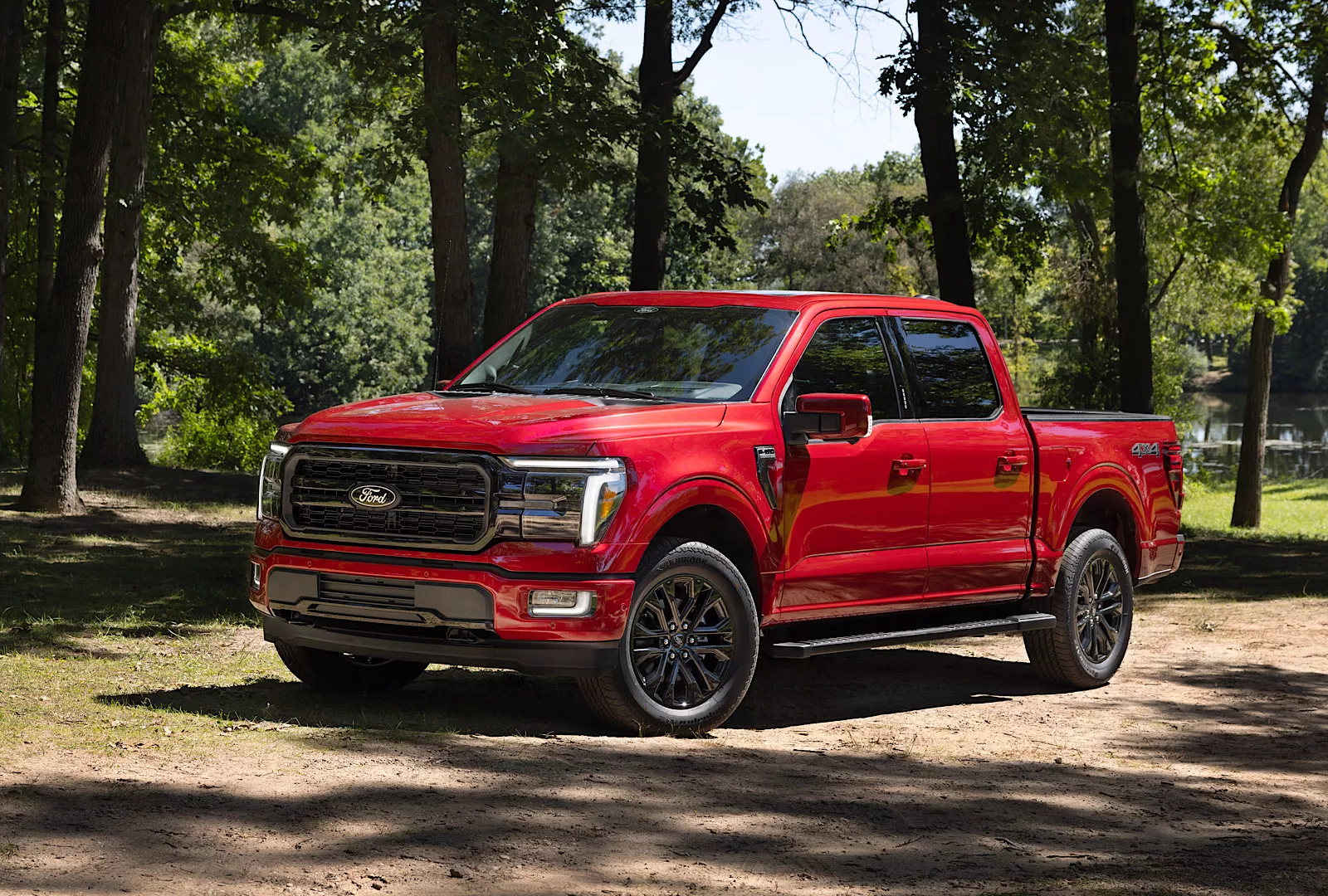
The truck’s brake controller intelligently balances regenerative and friction braking to maximize energy recovery while maintaining a natural pedal feel and predictable deceleration rates.
This system functions seamlessly even when approaching maximum payload capacity, where braking demands are significantly higher.
The PowerBoost’s advanced thermal management system contributes significantly to its efficiency by maintaining optimal operating temperatures for both the gasoline engine and the electric powertrain components.
The system includes electric water pumps that operate only when needed, reducing parasitic losses typically associated with belt-driven accessories. Additionally, the hybrid system allows for extended engine-off operation during appropriate conditions, even with climate control systems running.
The F-150 PowerBoost’s primary limitations appear during extended high-power demands, such as prolonged towing up steep grades, where the hybrid system’s contribution becomes less significant as the battery’s state of charge decreases.
The additional weight of the hybrid components also slightly reduces the maximum payload capacity compared to conventional F-150 variants.
Nevertheless, the system’s performance demonstrates the viability of hybrid technology for enhancing fuel economy in full-size trucks, particularly for operators whose usage patterns include frequent stop-and-go driving mixed with highway operation.
8. Chevrolet Silverado 1500 Duramax Diesel
The Chevrolet Silverado 1500 equipped with the 3.0-liter Duramax inline-six turbo diesel earned 18.3 MPG during heavy-load testing, placing it eighth but first among light-duty trucks.
This impressive performance showcases the inherent efficiency advantages of modern diesel technology when applied to half-ton platforms.
The Duramax produces 277 horsepower and a substantial 460 lb-ft of torque, delivered through GM’s 10-speed automatic transmission that provides an ideal balance of low-end grunt and highway efficiency.
The Silverado’s diesel engine employs state-of-the-art technologies including an aluminum block for weight reduction, a variable-geometry turbocharger for optimal boost across the RPM range, and high-pressure common-rail fuel injection delivering precise multiple injection events per combustion cycle.
During testing, the engine demonstrated remarkable thermal efficiency, converting a higher percentage of fuel energy into useful work compared to gasoline alternatives.
The low-friction design with offset cylinder design and variable-displacement oil pump further enhances efficiency under all operating conditions.
Under heavy loads, the Silverado’s intelligent transmission control system demonstrated sophisticated load-detection algorithms that kept the engine operating primarily in its torque peak range between 1,500-3,000 RPM, where diesel engines achieve optimal efficiency.

The transmission’s closely spaced lower gears provided precise control for starting on grades with heavy loads, while the overdrive ratios allowed for relaxed highway cruising with the engine turning just above idle at 65 mph.
Aerodynamically, the Silverado 1500 incorporates an active air dam that automatically lowers at highway speeds to reduce undercarriage drag.
This system, combined with active grille shutters and carefully designed body contours, helps minimize the efficiency penalty associated with the truck’s substantial frontal area.
The testing revealed that these aerodynamic enhancements provided increasing benefits as speeds climbed above 55 mph, even when heavily loaded.
The Silverado Duramax’s primary limitations appeared during cold operation, where the diesel required more time to reach optimal operating temperature compared to gasoline alternatives.
Additionally, the emissions control system occasionally initiated regeneration cycles that temporarily impacted fuel economy.
However, once at operating temperature and in normal operation mode, the Duramax demonstrated remarkable consistency in fuel consumption regardless of terrain or load conditions within its rated capacity.
9. RAM 1500 EcoDiesel
The RAM 1500 equipped with the 3.0-liter EcoDiesel V6 achieved 17.7 MPG during heavy-load testing, placing it ninth and second among light-duty trucks.
This performance highlights the efficiency of RAM’s approach to diesel integration in half-ton platforms, combining a relatively compact displacement with sophisticated engine management systems.
The EcoDiesel generates 260 horsepower and 480 lb-ft of torque, delivered through RAM’s smooth-shifting 8-speed automatic transmission from ZF.
Under heavy loads, the EcoDiesel’s distinctive V6 architecture demonstrates an excellent balance between power delivery and efficiency. The 60-degree cylinder bank angle minimizes vibration without requiring balance shafts that would otherwise create parasitic losses.
The dual overhead camshaft design with chain-driven camshafts ensures precise valve timing control while maintaining long-term durability.
During testing, the engine operated remarkably quietly for a diesel, even under sustained high-load conditions.
The RAM 1500’s innovative air suspension system contributes significantly to its efficiency by automatically lowering the truck at highway speeds to reduce aerodynamic drag.
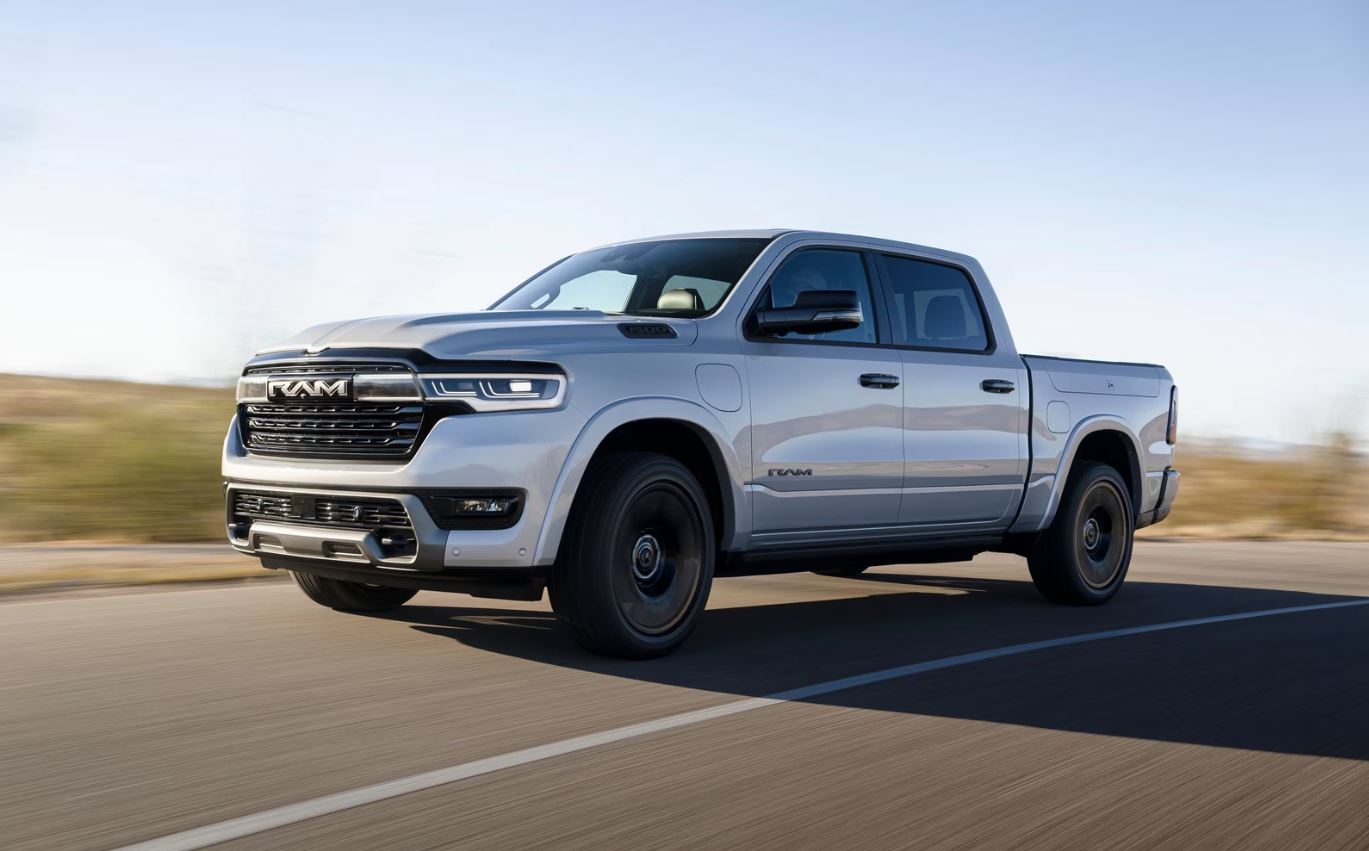
This system provides a dual benefit of improved ride quality with heavy loads while simultaneously enhancing fuel economy through reduced wind resistance.
The active air dam further reduces undercarriage turbulence at highway speeds, working in conjunction with the smooth underbody panels to minimize drag.
RAM’s implementation of thermal management technology includes an active warmup system that brings the engine to operating temperature more quickly and maintains optimal oil and coolant temperatures through precisely controlled coolant flow.
This system proved particularly beneficial during testing in cooler ambient conditions, where diesel engines typically suffer efficiency penalties during warmup phases. The electronic viscous fan clutch operates only when needed, reducing parasitic losses when full cooling capacity isn’t required.
The EcoDiesel’s primary limitations appeared during rapid acceleration demands and higher-speed operation, where its relatively modest horsepower rating occasionally required downshifts that momentarily reduced efficiency.
The emissions control system also initiated periodic regeneration cycles that temporarily impacted fuel economy, though less noticeably than in some competitors.
Despite these minor drawbacks, the RAM 1500 EcoDiesel demonstrates the significant potential for diesel powertrains in light-duty applications, particularly for operators who regularly haul substantial loads.
10. Ford F-150 EcoBoost 3.5L
The Ford F-150 equipped with the 3.5-liter EcoBoost V6 recorded 14.3 MPG during heavy-load testing, placing it tenth. This performance demonstrates the effectiveness of Ford’s approach to high-output gasoline engines for truck applications, combining twin turbocharging with direct injection and advanced electronic control.
The EcoBoost produces 400 horsepower and 500 lb-ft of torque in this configuration, delivered through Ford’s 10-speed automatic transmission co-developed with General Motors.
Under heavy loads, the EcoBoost engine demonstrates remarkable power density, producing outputs comparable to much larger displacement naturally aspirated engines while maintaining better efficiency under partial-load conditions.
The twin-turbocharger configuration, with one turbo serving each bank of the V6, provides excellent throttle response by minimizing turbo lag.
During testing, the engine consistently delivered strong acceleration even when approaching maximum payload capacity, without requiring extreme transmission downshifts that would harm efficiency.
The F-150’s implementation of port and direct fuel injection technology (dual injection) contributes significantly to efficiency by optimizing fuel delivery based on operating conditions.
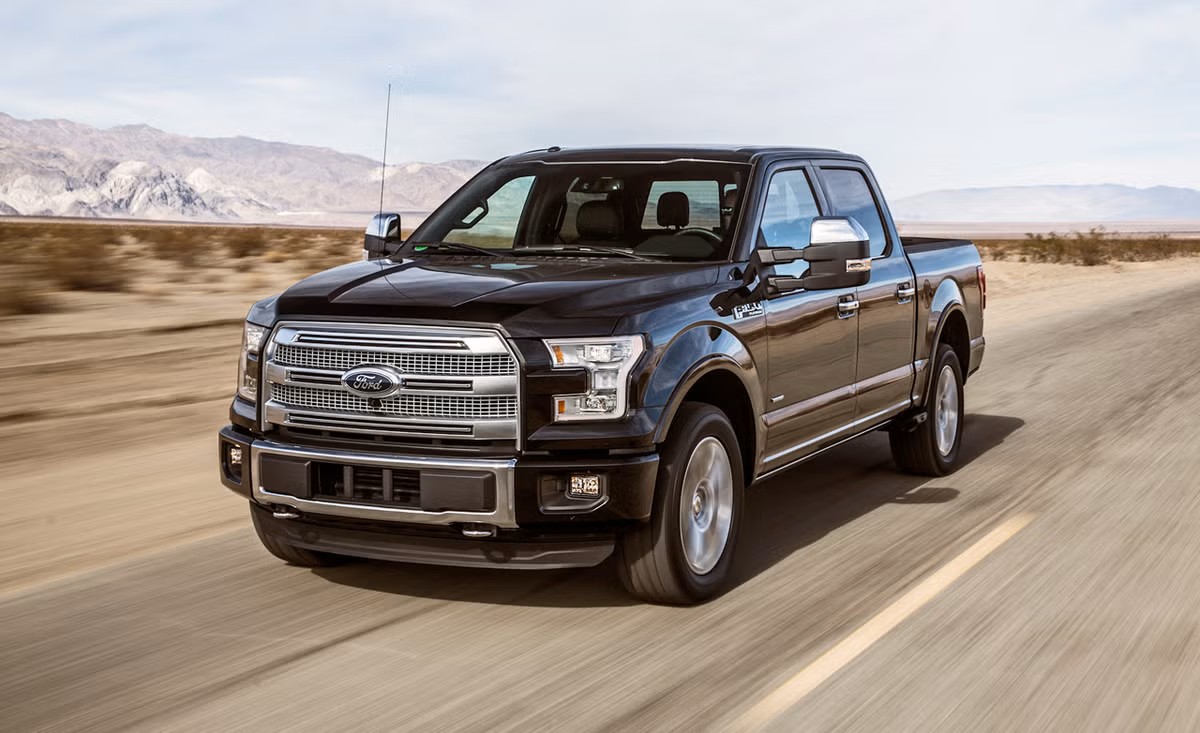
At lower loads, port injection provides smooth operation and reduced carbon buildup, while under heavy loads, direct injection cools the intake charge for improved knock resistance and combustion efficiency.
The electronically controlled wastegates on the turbochargers precisely manage boost pressure to deliver exactly the required power without excess fuel consumption.
Ford’s advanced thermal management system includes split cooling for the engine block and cylinder heads, allowing for different operating temperatures in various parts of the engine.
This system optimizes combustion efficiency while protecting critical components from excessive thermal stress during heavy-load operation.
The electronic thermostat and variable-speed water pump further enhance efficiency by minimizing parasitic losses when full cooling capacity isn’t required.
The EcoBoost’s primary limitations appeared during extended full-load operation, where the turbochargers generate significant heat that eventually requires fuel enrichment for component protection, temporarily reducing efficiency.
Additionally, the high-output nature of the engine occasionally resulted in downshifts during hill climbs that increased fuel consumption.
Despite these characteristics, the F-150 EcoBoost represents an effective approach to delivering diesel-like torque from a gasoline platform, particularly for operators who prefer gasoline engines but still require substantial towing and hauling capability.
11. GMC Sierra 1500 AT4X 6.2L
The GMC Sierra 1500 AT4X equipped with the naturally aspirated 6.2-liter V8 achieved 12.1 MPG during heavy-load testing, placing it eleventh in comparison.
This performance reflects the inherent challenges of maintaining efficiency with a large-displacement naturally aspirated engine when operating under heavy loads, particularly in an off-road-oriented configuration like the AT4X.
Nevertheless, the 6.2-liter V8 delivers robust power output at 420 horsepower and 460 lb-ft of torque, providing confident acceleration and towing capability through the 10-speed automatic transmission.
Under heavy loads, the naturally aspirated V8 demonstrates linear power delivery and immediate throttle response without the turbo lag sometimes experienced with forced-induction alternatives.
The engine’s Dynamic Fuel Management system, which can deactivate cylinders in 17 different patterns to optimize efficiency, proved less effective under heavy loads where most or all cylinders remain active continuously.
However, during moderate acceleration and steady-state cruising, the system occasionally deactivated cylinders even with substantial payloads, contributing incremental efficiency improvements.
The AT4X’s specialized off-road equipment, including 32-inch Goodyear Wrangler Territory mud-terrain tires and Multimatic DSSV dampers, creates additional efficiency challenges through increased rolling resistance and ride height compared to standard Sierra models.
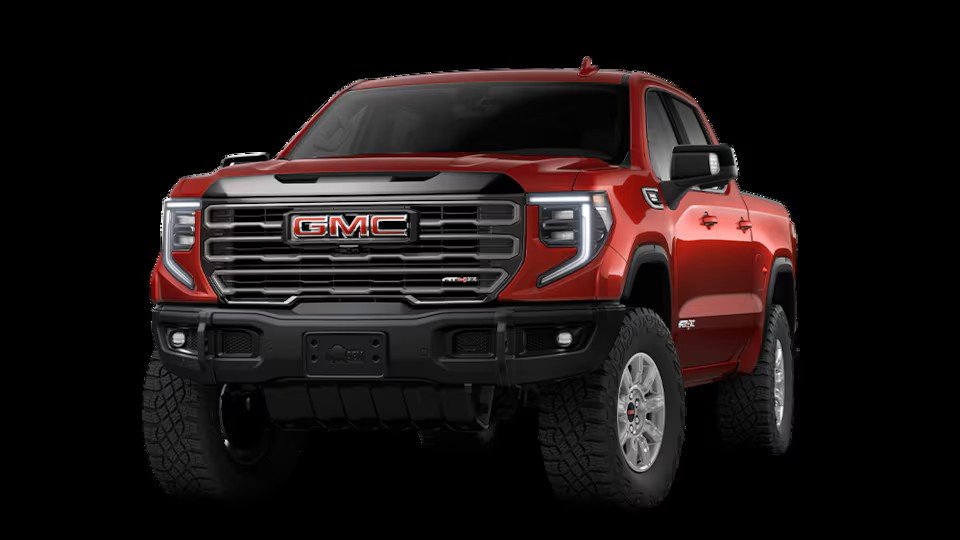
These features provide exceptional off-road capability but come with measurable fuel economy penalties, particularly at highway speeds where aerodynamic drag increases significantly. The AT4X’s standard skid plates, while providing essential underbody protection, also disrupt airflow and contribute to increased drag.
GMC’s implementation of advanced combustion technology includes direct fuel injection with precisely controlled multiple injection events per cycle, variable valve timing, and high-compression-ratio design enabled by sophisticated knock detection systems.
These technologies help extract maximum efficiency from the naturally aspirated design despite the inherent thermodynamic limitations compared to forced-induction or diesel alternatives.
The high-flow exhaust system minimizes backpressure while maintaining appropriate sound levels, reducing pumping losses that typically increase under heavy loads.
The Sierra AT4X’s primary efficiency limitations stem from its performance-oriented gearing and aggressive tires combined with the high-displacement engine’s greater baseline fuel consumption.
However, for operators who prioritize off-road capability and naturally aspirated reliability over maximum fuel economy, the Sierra AT4X represents a capable platform that maintains reasonable efficiency considering its specialized configuration.
12. Toyota Tundra TRD Pro
The Toyota Tundra TRD Pro, powered by the standard 3.5-liter twin-turbocharged V6 (non-hybrid) engine, recorded 11.9 MPG during heavy-load testing, placing it twelfth in comparison.
This performance reflects the efficiency challenges inherent to the TRD Pro’s off-road-focused configuration, which prioritizes rugged capability over maximum fuel economy. The engine produces 389 horsepower and 479 lb-ft of torque, delivered through Toyota’s responsive 10-speed automatic transmission.
Under heavy loads, the twin-turbocharged V6 demonstrates good low-end torque delivery that helps maintain momentum without excessive downshifting on challenging terrain.
The dual VVT-i (Variable Valve Timing-intelligent) system optimizes both intake and exhaust valve timing across operating conditions, helping extract maximum efficiency from each combustion event.
During testing, the engine maintained consistent performance even when approaching maximum payload capacity, though efficiency declined more noticeably than some competitors.
The TRD Pro’s specialized off-road equipment creates substantial efficiency challenges, particularly the 2.5-inch FOX internal bypass shocks with piggyback reservoirs and the TRD-specific front coil springs that increase ride height by 1.1 inches over standard Tundra models.
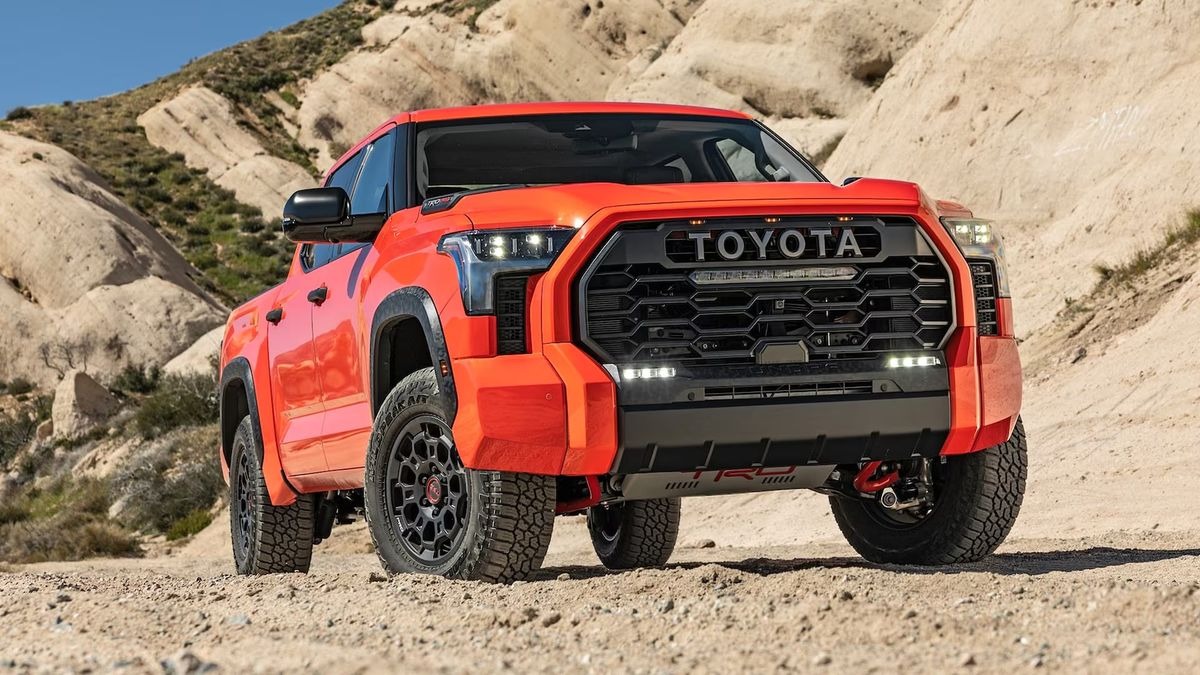
The aggressive all-terrain tires with reinforced sidewalls provide excellent off-road grip but significantly increase rolling resistance compared to highway-oriented alternatives.
These features combine to create both increased mechanical drag and greater aerodynamic resistance, particularly at highway speeds.
Toyota’s implementation of D-4S injection technology, which combines direct and port fuel injection, helps optimize combustion efficiency across varying load conditions.
At lower loads, port injection provides better fuel atomization and reduces carbon buildup on intake valves, while under heavy loads, direct injection provides charge cooling effects that improve knock resistance.
The electronic wastegate control precisely manages to boost pressure to deliver appropriate power without excessive fuel consumption.
The Tundra TRD Pro’s efficiency limitations primarily stem from its specialized configuration optimized for off-road performance rather than highway efficiency.
The increased ride height, aggressive tire pattern, and additional underbody protection all create efficiency penalties that become particularly apparent under heavy loads.
However, for operators who require maximum off-road capability combined with substantial payload capacity, the TRD Pro represents a compelling option that balances these competing priorities while maintaining reasonable, if not class-leading, fuel economy.
Also Read: 10 Budget Sports Cars Perfect for Custom Modifications

